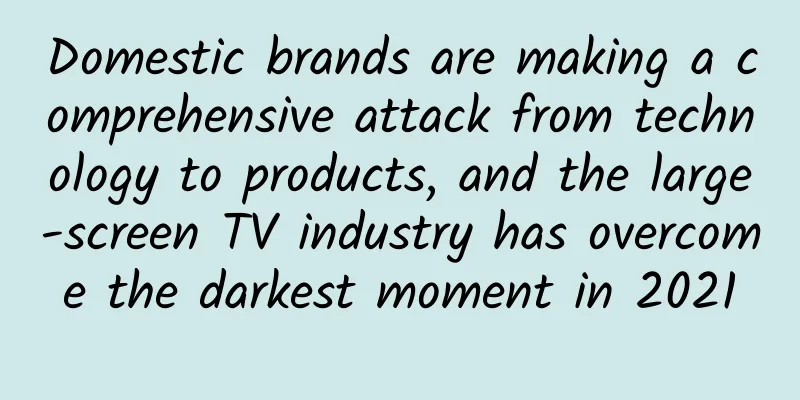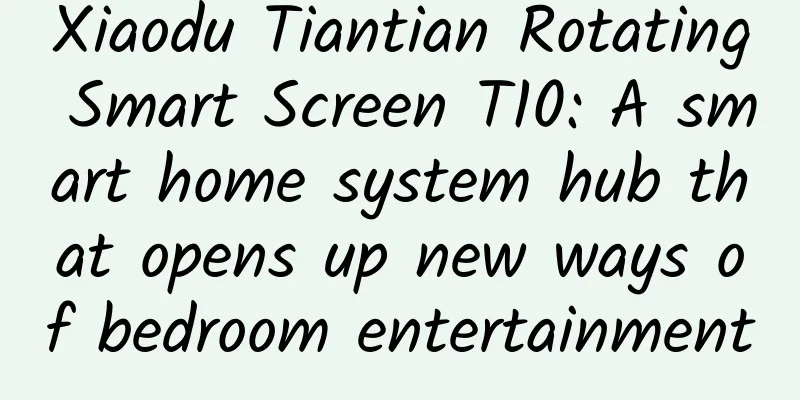Domestic brands are making a comprehensive attack from technology to products, and the large-screen TV industry has overcome the darkest moment in 2021

|
Suffering from lack However, a major highlight of the industry is that although the domestic TV retail scale this year has decreased by 13.8% year-on-year, the retail sales have increased by 7.2% year-on-year, showing a clear trend of decreasing volume and increasing prices. In this context, major domestic and foreign brands have also launched products with their own characteristics this year in order to stand out in the fierce competition. Here are a few of the most representative products, from which we can see some of the development of the industry and the upgrading of user needs. Newcomers in the premium TV spaceWhen the TV market as a whole entered the stock market, major brands naturally began to transform to the high-end, which also promoted the development of new technologies. Technologies such as dynamic compensation, wide color gamut, and zone light control are not to be mentioned. The underlying display technologies such as OLED and Mini LED are also developing rapidly, bringing a new viewing experience to the audience. OLED is a fast-growing category in the TV industry today, especially in the high-end market of over $1,500, where it has accounted for more than 45%. The biggest advantage of OLED TVs over traditional LCD TVs is that they use organic light-emitting materials, which can achieve self-luminescence and do not require backlight, so the TV can be made thinner. More importantly, OLED can display true black, which makes the contrast and picture quality of the picture even better. In the field of OLED TV, LG is the undisputed leader. Almost all TV OLED panels today come from this Korean giant. The LG OLED C1 launched this year is an excellent reflection of LG's OLED product strength. LG C1 uses LG's most advanced OLED technology, and the AI audio and video chip it carries is also a self-developed product of LG, so it can achieve full-blooded operation in the true sense. 4K, 120Hz, HDR are naturally no problem, and the four HDMI 2.1 interfaces also ensure rich scalability. It can be said that whether watching videos or playing games, LG C1 can bring a top-level experience. If there are any shortcomings of the LG C1, the first is the durability of the OLED material, after all, LG has a history of OLED TV screen burn-in. Another is its price: the 77-inch version costs 34,000 yuan, and the 83-inch version costs 54,000 yuan. LG's Korean compatriot Samsung was not willing to hand over the control of high-end panels to LG, so it began to study quantum dot matrix technology. This technology is an emerging Mini LED technology that can achieve precise light control, allowing more details to be displayed in dark and bright scenes. At the same time, it can effectively improve the defects of OLED TVs such as short life and low brightness. Samsung's QN90A series launched this year is a representative product of this technology. This product is equipped with Samsung's self-developed Neo quantum dot 4K processor, which can optimize viewing conditions frame by frame and improve picture quality. The peak brightness of 1850 nits, 792 backlight zones, and 95% P3 wide color gamut make its picture shocking enough. As a high-end product, the price of Samsung QN90A series is not friendly either. The price of 65 inches reaches 19,000 yuan. It is more suitable for people with strong financial resources and more willing to try new technologies. Domestic brands are also making great strides into the high-end market. In the field of Mini LED, TCL has always been a leader in China and one of the few manufacturers in China that can produce Mini LED panels. In 2020, it accounted for 90% of the global Mini LED product market share. This year, TCL launched the Lingxi C12 Quantum Dot Mini LED Smart Screen, which is its representative product. The backlight of this product is composed of 3840 micron-level LED chips, the peak brightness of the screen reaches 1000 nits, and the contrast ratio is 10 million to 1. Due to the use of more durable luminous materials, C12 can ensure that the screen will not fade for 10 years, which is convenient for long-term use. Another major feature of C12 is its full-scenario AI capability. Today's TVs are no longer just home entertainment centers, but have also become the control center of smart homes. C12 supports many smart home control functions, and can be used as a smart speaker when the screen is off. In addition, it also supports distributed whole-house smart control, video calls, cross-screen streaming of audio and video, gesture-based air operations, and other functions, which greatly broadens its usage scenarios. Huawei, which has always been known for its R&D capabilities, has also made its own exploration in the field of Mini LED. This year, they launched the Huawei Smart Screen V75 Super. Compared with other Mini LED products, the biggest feature of V75 Super is that it uses Huawei's self-developed Honghu SuperMiniLED precision matrix backlight solution, which has a total of 46,080 Mini LED lamp beads, 2,880 backlight partitions, and a peak brightness of up to 3,000 nits. This has greatly improved the light control precision of this TV. When combined with the clear light control Pro+ technology, it can achieve real-time partition brightness adjustment of the picture frame by frame, making the display effect more realistic and natural. The V75 Super is also connected to the Hongmeng smart ecosystem and can support multi-tasking at the same time, allowing users to watch TV while video chatting with friends and family. In addition, functions such as AI fitness and smart home control can also be realized on this TV. It can be said that in the field of high-end TVs, Korean companies that started earlier still hold a lot of advanced technologies and have certain advantages in terms of market share and performance. However, the excellent products launched by manufacturers such as TCL and Huawei this year have shown us that Chinese brands also have outstanding strength and huge potential in the high-end market. In the pursuit of high-end display technology, Chinese brands will no longer lag behind. Can traditional powerful people still survive?In addition to the various new materials that are competing with each other, some flagship products use more "traditional" technologies and also demonstrate excellent product strength. The X90J series launched by Sony this year uses the relatively "outdated" DLED direct backlight, but the configuration in other aspects is not ambiguous: full-array backlight, 32 light control zones, and 120Hz refresh rate can all bring a very good viewing experience. In addition, the X90J is also equipped with Sony's own XR chip, which can restore the rich details of the picture through cross-data analysis and intelligent algorithms, while making the colors more realistic and the contrast stronger, and even able to focus on the focal point like the human eye, making the picture more three-dimensional. As one of the world's largest game console manufacturers, Sony naturally pays special attention to the gaming functions of its TVs. The X90J is specially designed for PS5. The HDR automatic mapping function allows the PS5 to optimize the TV's HDR settings during initial settings to obtain a better picture. The content adaptive image mode can distinguish whether the user is playing games or watching movies, and automatically switches to game mode when playing games to reduce input delay, and switches to standard mode when watching movies to enhance picture quality. Hisense has integrated various real-world technologies on LED TVs and continued to deepen ULED technology. In addition to optimizing picture color and brightness, it has also done a lot of work on zone light control. The U7G-Pro launched by Hisense this year is a representative product of ULED technology. This product is equipped with the Hisense U+ ultra-high-definition chip, which can intelligently identify and analyze the picture to improve the picture performance. The U7G-Pro has 120 backlight partitions, which are more detailed and can achieve more accurate light control, making the picture more impactful. In other aspects, the U7G-Pro's stacking is also unambiguous: 144Hz refresh rate, 97% DCI-P3 color gamut, 1600 nits peak brightness, WAVES master audio, AI camera, 3GB+128GB memory, and NAS private cloud all make it a well-deserved flagship product. It can be seen that although new materials and technologies such as OLED and Mini LED are coming in full force, after incorporating some technological innovations, the most traditional LED TVs can still demonstrate their product strength in 2021. In the next few years, the status of LED TVs will not be easily replaced. Let more people experience new technologies with cost-effectivenessCost-effectiveness has long been a hallmark of domestic TV manufacturers. In the past, when people mentioned cost-effectiveness, they would think of buying a TV with a configuration of 2,999 yuan at a price of 1,999 yuan. However, in this year's TV market, a different approach has emerged. Xiaomi, known as the "price butcher", has also not let go of the TV field and has set its sights on OLED TVs this year. The starting price of the Xiaomi TV 6 OLED version launched this year is only 4,999 yuan, which is particularly eye-catching among OLED TVs that start at tens of thousands of yuan. This TV has a contrast ratio of 1 million to 1, a peak brightness of 800 nits, and supports 10-bit color depth, MEMC motion compensation and other functions. Overall, its viewing experience is still very good. However, this TV is certainly not without its shortcomings. For example, the refresh rate is only 60Hz and there is no HDMI 2.1, so it is not suitable for gamers. In addition, its chip is not of the highest specification, so the smoothness of use may not be guaranteed, and the 32GB memory is still a bit stretched if you want to use it to store movies. Finally, there is the disgusting startup advertisement. But in any case, as possibly the cheapest OLED TV on the market, the Xiaomi TV 6 OLED version still provides more people with the possibility of getting in touch with OLED TVs, which is worthy of recognition. Coincidentally, in the Mini LED field, a player has emerged that has lowered the entry threshold for the entire category, and that player is Thunderbird. Since Thunderbird and TCL have the same origin, the Thunderbird 645C series of Mini LED TVs launched this year uses Mini LED panels from China Star Optoelectronics. The peak brightness of 1100 nits, 128 backlight zones (55-inch version), 96% DCI-P3 wide color gamut, 10-bit color depth, and 120Hz refresh rate make this product particularly attractive in the price range of less than 6,000 yuan. In addition, Thunderbird 645C also supports far-field voice, Dolby Vision, interconnected screen projection and other functions. The UI 5.0 developed by Thunderbird Technology is also a leading smart TV system in China, with rich film and television, game resources, and rich functions to meet the needs of a variety of people. Xiaomi and Thunderbird have shown us another possibility of "cost-effectiveness" this year. In this era when TVs under 3,000 yuan are everywhere, 4,500 to 6,000 yuan may not be the traditional "cost-effectiveness" price range, but Xiaomi and Thunderbird have brought more advanced technology into this price range that is acceptable to most people without sacrificing the overall quality of the TV. Compared with simply competing on low prices, using this method to improve the cost-effectiveness of products seems to be healthier. To overcome the "darkest moment", only products can be strengthenedIt is generally believed that the color TV market in 2021 has reached its "darkest hour". Indeed, this year's color TV market has reached its lowest point in a decade, especially with the industry's profit margin of only 1.8%, which is almost negligible compared with products such as mobile phones. But fortunately, in such a market environment, we have seen that major brands are still exploring in different price ranges. In addition to the brands mentioned above, OPPO, Skyworth, Honor and other brands have also launched many excellent products in 2021. Faced with an extremely challenging market environment, TV manufacturers can only stimulate users' desire to upgrade by continuously innovating in technology and improving product quality. On the one hand, TV brands should actively develop the most cutting-edge display technology to make their products more competitive. At the same time, TV brands should also actively expand the use scenarios of TV products to change the current status of TV in modern life scenarios. In short, if you want your brand to survive, your products must be strong. As a winner of Toutiao's Qingyun Plan and Baijiahao's Bai+ Plan, the 2019 Baidu Digital Author of the Year, the Baijiahao's Most Popular Author in the Technology Field, the 2019 Sogou Technology and Culture Author, and the 2021 Baijiahao Quarterly Influential Creator, he has won many awards, including the 2013 Sohu Best Industry Media Person, the 2015 China New Media Entrepreneurship Competition Beijing Third Place, the 2015 Guangmang Experience Award, the 2015 China New Media Entrepreneurship Competition Finals Third Place, and the 2018 Baidu Dynamic Annual Powerful Celebrity. |
Recommend
There is actually "high-tech material" hidden in the sweet and sour spare ribs! What is it that is so amazing?
Following nanomaterials, quantum materials have b...
Lanzhou mini program promotion and traffic generation methods, how to promote mini program and traffic generation?
Recently, many customers have asked me what to do ...
Can towering trees really reach the sky? How tall can trees really grow? | Science Museum
It is said that "ancient trees are towering&...
How to build your own AARRR operating model?
Every time I talk with my peers about operations ...
From the Buddhist country to the human world, what has China’s “tower” experienced?
↑A group of National Geographic fans, focusing on...
How much does it cost to customize a mechanical equipment mini program in Chuxiong?
How much is the quotation for customized Chuxiong...
I've never seen such a thing before! How can this lamp last for 150 years?
You must have heard of the existence of "ete...
Top 5 tools for cross-platform mobile app development
[51CTO Translation] This article introduces five ...
Now that the industry has stopped booming, can drone racing still become an e-sports sport?
From exploiting human nature to capturing people&#...
Let’s take a look at a healing story about Siri
What can Siri do? Ask about the weather, ask abou...
Car Home Page Performance Monitoring Construction Practice
1. Introduction Paying attention to user experien...
Chinese Valentine's Day is coming, and you have no idea for a marketing plan? Look at this for inspiration!
If you can’t plan a marketing plan to create a hot...
A case study on efficient advertising and customer acquisition optimization in the beauty industry!
With the development of society, the growth momen...
Are you stressed? The puppy passing by also cares | Nature Trumpet
Shark struck by boat Recently, scientists recorde...
Free APP promotion, what strategies do startups need!
In this era of mass entrepreneurship , there are ...









